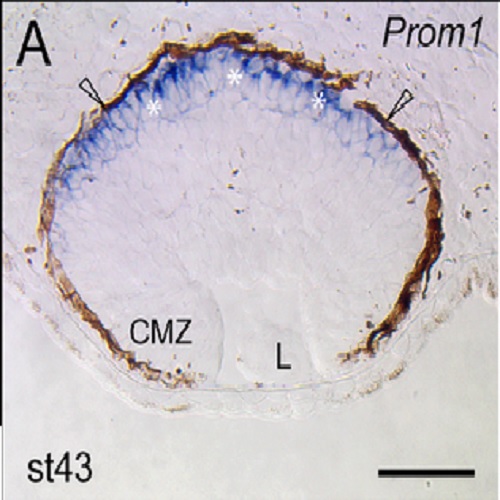Distinct and conserved prominin-1/CD133-positive retinal cell populations identified across species.
Besides being a marker of various somatic stem cells in mammals, prominin-1 (CD133) plays a role in maintaining the photoreceptor integrity since mutations in the PROM1 gene are linked with retinal degeneration. In spite of that, little information is available regarding its distribution in eyes of non-mammalian vertebrates endowed with high regenerative abilities. To address this subject, prominin-1 cognates were isolated from axolotl, zebrafish and chicken, and their retinal compartmentalization was investigated and compared to that of their mammalian orthologue. Interestingly, prominin-1 transcripts--except for the axolotl--were not strictly restricted to the outer nuclear layer (i.e., photoreceptor cells), but they also marked distinct subdivisions of the inner nuclear layer (INL). In zebrafish, where the prominin-1 gene is duplicated (i.e., prominin-1a and prominin-1b), a differential expression was noted for both paralogues within the INL being localized either to its vitreal or scleral subdivision, respectively. Interestingly, expression of prominin-1a within the former domain coincided with Pax-6-positive cells that are known to act as progenitors upon injury-induced retino-neurogenesis. A similar, but minute population of prominin-1-positive cells located at the vitreal side of the INL was also detected in developing and adult mice. In chicken, however, prominin-1-positive cells appeared to be aligned along the scleral side of the INL reminiscent of zebrafish prominin-1b. Taken together our data indicate that in addition to conserved expression of prominin-1 in photoreceptors, significant prominin-1-expressing non-photoreceptor retinal cell populations are present in the vertebrate eye that might represent potential sources of stem/progenitor cells for regenerative therapies.

- PLoS ONE 2011 Mar 02;6(3):e17590
- 2011
- Cell Biology
- 21407811
- PubMed
Enabled by:
